

UCJEPS: Jepson Interchange: Zizania aquatica L. ITIS Standard Report Page: Zizania aquatica. CalPhotos. Zizania aquatica information from NPGS/GRIN. UW-System WisFlora Home. Zizania aquatica - Species Page - ISB: Atlas of Florida Vascular Plants. Select the criterion by which you wish to search (Scientific name, Genus, Family, etc.) and enter that information into the provided field.
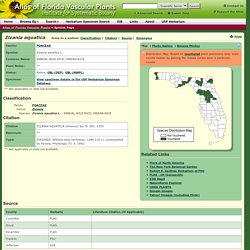
Hint: Correct spelling is necessary for desired results, but because this function is a string search the full name need not be entered. Info2. Info. Results of search. Plants Profile for Zizania aquatica (annual wildrice) Cannabis (drug) Cannabis is often consumed for its psychoactive and physiological effects, which can include heightened mood or euphoria, relaxation,[10] and an increase in appetite.[11] Unwanted side-effects can sometimes include a decrease in short-term memory, dry mouth, impaired motor skills, reddening of the eyes,[10] and feelings of paranoia or anxiety.[12] Effects Main short-term physical effects of cannabis A 2013 literature review said that exposure to marijuana had biologically-based physical, mental, behavioral and social health consequences and was "associated with diseases of the liver (particularly with co-existing hepatitis C), lungs, heart, and vasculature".[21] The medicinal value of cannabis is disputed.

The American Society of Addiction Medicine dismisses the concept of medical cannabis because the plant fails to meet its standard requirements for approved medicines. Neurological Gateway drug Safety Varieties and strains Types of cannabis. Salatingredienser. Flerårig grønnkål (Brassica oleracea «Daubenton») Svartrot/Skorsonerrot (Scorzonera hispanica) Brassica oleracea «Daubenton» Løvetann (Taraxacum officinale (fransk)snl.no Norrlandsløk (Allium«Norrlandsløk») Taraxacum sublaciniosum «delikatess»
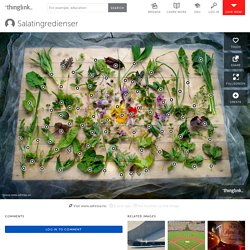
Grow Your Heirlooms » Because Dependency Sucks! Heirloomseedsaving.com. Gardening Questions and Organic Garden Information. Edible Oasis. Grow Food Everywhere. North Quabbin Energy. Warwick earns Green Community Designation — December, 2014 Warwick is now one of 13 new Green Communities, recently designated on Dec. 3 2014, and awarded $137,850 to begin implementing their 20% energy reduction plan over the next 5 years.

Untitled. The Napa Valley may become known for another crop aside from its world-renowned grapes.

On Saturday, a giant pumpkin from the valley set a world record during a weigh-off at Morgan Hill in the South Bay. The pumpkin, grown for 105 days in a backyard in east Napa, tipped the scale at 2,032 pounds at the 23rd annual Giant Pumpkin Weigh-Off, hosted by Uesugi Farms. Buy live pet insect. Helpful Insects. Although insects are commonly thought of as pests in just about every region of the world, one must take the time to realize their benefits in our everyday lives.
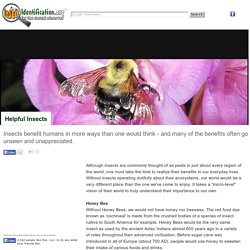
Without insects operating dutifully about their ecosystems, our world would be a very different place than the one we've come to enjoy. It takes a "micro-level" vision of their world to truly understand their importance to our own. Honey Bee Without Honey Bees, we would not have honey nor beeswax. The red food dye known as 'cochineal' is made from the crushed bodies of a species of insect native to South America for example. Honey Bees would be the very same insect as used by the ancient Aztec Indians almost 600 years ago in a variety of roles throughout their advanced civilization. Dragonfly pets? Aphid. Aphids, also known as plant lice and in Britain and the Commonwealth as greenflies, blackflies, or whiteflies (not to be confused with "jumping plant lice" or true whiteflies), are small sap-sucking insects, and members of the superfamily Aphidoidea.[1] Aphids are among the most destructive insect pests on cultivated plants in temperate regions.[1] The damage they do to plants has made them enemies of farmers and gardeners the world over, though from a zoological standpoint they are a highly successful group of organisms.[2] Their success is due in part to the asexual reproductive capabilities of some species.

About 4,400 species are known, all included in the family Aphididae.[3] Around 250 species are serious pests for agriculture and forestry as well as an annoyance for gardeners. They vary in length from 1 to 10 millimetres (0.04 to 0.39 in). Distribution[edit] Aphids are distributed worldwide, but are most common in temperate zones. Taxonomy[edit] Anatomy[edit] Diet[edit] Hoverfly. About 6,000 species in 200 genera have been described.
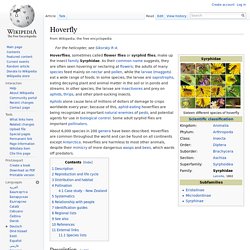
Hoverflies are common throughout the world and can be found on all continents except Antarctica. Hoverflies are harmless to most other animals, despite their mimicry of more dangerous wasps and bees, which wards off predators. Description[edit] No-till farming. Young soybean plants thrive in and are protected by the residue of a wheat crop.
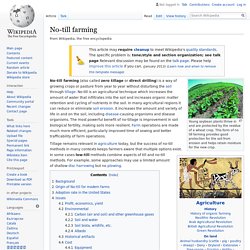
This form of no till farming provides good protection for the soil from erosion and helps retain moisture for the new crop. No-till farming (also called zero tillage or direct drilling) is a way of growing crops or pasture from year to year without disturbing the soil through tillage. No-till is an agricultural technique which increases the amount of water that infiltrates into the soil and increases organic matter retention and cycling of nutrients in the soil. In many agricultural regions it can reduce or eliminate soil erosion. It increases the amount and variety of life in and on the soil, including disease-causing organisms and disease organisms.
What is Air Pruning? By Sunny Datko Air pruning is a technique designed to encourage the plant to grow a denser system of root hairs, increasing nutrient absorption and enabling the plant to grow more rapidly.

Air pruning works by exposing the root tips to relatively dry air, causing the apical cells at the very tip of the root to dehydrate, or become air-pruned. This stimulates the growth of secondary roots that branch out from them within the growing media. These secondary roots spread throughout the container until they reach the sides and bottom where they get air pruned again, stimulating more root growth. The overall effect of this technique is the establishment of a well-developed root system that is spread evenly throughout the entire pot.
The Cost Savings Of Growing Food - 2014 Edition. What Will We Eat? Healing Herbal.